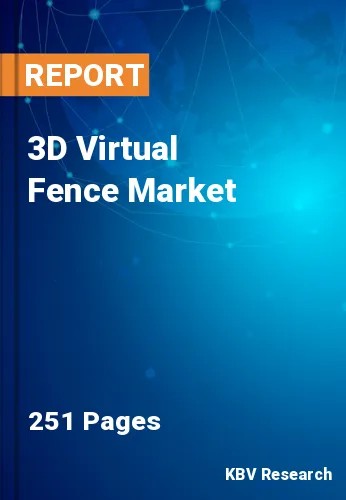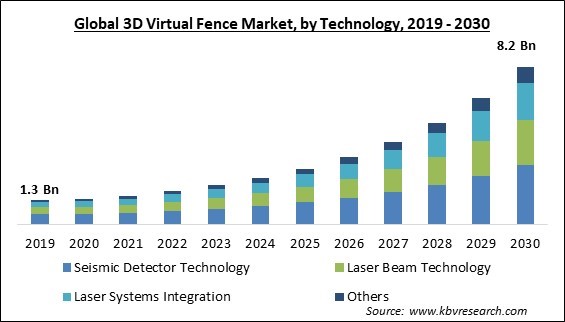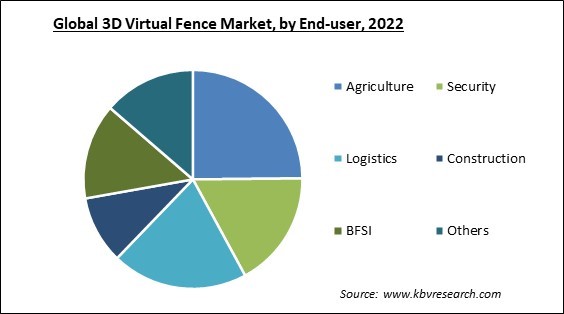
The Global 3D Virtual Fence Market size is expected to reach $8.2 billion by 2030, rising at a market growth of 21.9% CAGR during the forecast period.
Rising security threats, including terrorism, vandalism, theft, and unauthorized access, are compelling organizations to invest in advanced security solutions like 3D virtual fences to protect their assets and infrastructure. Therefore, security segment would generate $301.1 million revenue in the market in 2022. Heightened security concerns require more effective intrusion detection methods. These fences offer advanced capabilities for monitoring and detecting unauthorized access, breaches, and suspicious activities in real time. As a result, 3D virtual fences deployed in critical locations, public spaces, and transportation hubs to deter potential threats and enhance public safety. 3D virtual fences help protect valuable assets, including equipment, inventory, and intellectual property. Some of the factors impacting the market are advancements in 3D virtual fence technology, expansion of agricultural applications, and high initial costs of 3D virtual fences.

Edge computing capabilities are integrated into 3D virtual fence systems, enabling data processing and decision-making at the sensor level. This reduces latency and enhances real-time response. High-speed and low-latency communication technologies like 5G networks enable seamless data transmission between sensors and central monitoring stations. This ensures that security personnel receive timely alerts. 3D virtual fence systems integrated with other security technologies, including surveillance cameras, access control systems, and drones. Additionally, these fences are increasingly adopted for livestock management, crop protection, and precision agriculture, improving productivity and resource efficiency. One of the primary agricultural applications of 3D virtual fences is livestock management. Farmers can use virtual fences to contain and manage their livestock without traditional physical fences. GPS and sensor technologies enable farmers to create virtual boundaries, and when animals approach or breach these boundaries, farmers receive real-time alerts. This helps prevent livestock from straying into neighboring properties or onto roads. These advancements address evolving security challenges and make 3D virtual fences more accessible and appealing to various industries, further driving the market's growth. As a result, it offers a versatile solution for farmers looking to modernize their operations and address various livestock and crop management challenges.
However, some 3D virtual fence systems require additional infrastructure, such as power sources and communication networks. Establishing or upgrading these infrastructures is costly. Customizing virtual fences to suit specific security needs or property layouts can incur additional expenses. Tailoring the technology to the unique requirements of each application increases costs. Scaling up the coverage area or adding additional sensors and equipment to an existing virtual fence system increases expenses. High initial costs are a significant challenge for the market. These costs are barriers to entry for many potential users and organizations, limiting the adoption of this advanced security technology.
On the basis of end-user, the market is divided into logistics, agriculture, security, BFSI, construction, and others. The border security segment garnered a significant revenue share in the market in 2022. 3D virtual fences comprehensively monitor the border area, including ground, airspace, and underground. This multi-dimensional approach helps border security personnel detect a wide range of threats. Virtual fence systems detect border intrusions in real-time, allowing for immediate response to potential threats, such as unauthorized crossings or smuggling attempts.

Based on technology, the market is classified into seismic detector technology, laser beam technology, laser systems integration, and others. In 2022, the seismic detector technology segment witnessed the largest revenue share in the market. Seismic detectors are highly sensitive to ground vibrations and can detect subtle disturbances, such as footsteps or tunneling attempts. When integrated into a 3D virtual fence system, they provide an additional detection layer for ground-level intrusions. Seismic detectors are particularly valuable for monitoring activities on the ground and underground. They detect tunneling attempts or movements beneath the surface, making them suitable for border security and critical infrastructure protection applications.
By type, the market is categorized into 3D video motion detection system and 3D virtual cameras. The 3D virtual cameras segment held the highest revenue share in the market in 2022. 3D virtual cameras detect and track objects with depth perception. This capability allows for more accurate and reliable object detection within the monitored area, reducing false alarms and improving overall security. Virtual fences are designed to detect unauthorized intrusions. 3D virtual cameras provide a three-dimensional view of the intrusion event, making it easier to assess the nature and location of the breach. 3D cameras capture data on the behavior of individuals within the monitored area.
| Report Attribute | Details |
|---|---|
| Market size value in 2022 | USD 1.7 Billion |
| Market size forecast in 2030 | USD 8.2 Billion |
| Base Year | 2022 |
| Historical Period | 2019 to 2021 |
| Forecast Period | 2023 to 2030 |
| Revenue Growth Rate | CAGR of 21.9% from 2023 to 2030 |
| Number of Pages | 251 |
| Number of Table | 380 |
| Report coverage | Market Trends, Revenue Estimation and Forecast, Segmentation Analysis, Regional and Country Breakdown, Companies Strategic Developments, Company Profiling |
| Segments covered | Type, Technology, End Use, Region |
| Country scope | US, Canada, Mexico, Germany, UK, France, Russia, Spain, Italy, China, Japan, India, South Korea, Australia & New Zealand, Malaysia, Brazil, Argentina, UAE, Saudi Arabia, South Africa, Nigeria |
| Growth Drivers |
|
| Restraints |
|
Region-wise, the market is analysed across North America, Europe, Asia Pacific, and LAMEA. In 2022, the Asia Pacific region led the market by generating the highest revenue share. Many countries in APAC are experiencing rapid urbanization, leading to the development of smart cities and the need for advanced security and surveillance infrastructure. 3D virtual fences can be integrated into smart city initiatives to enhance public safety and security. Various industries, including energy, manufacturing, and agriculture, are expanding in the APAC region. These industries require advanced security solutions to protect their assets and operations, creating opportunities for 3D virtual fence providers.
Free Valuable Insights: Global 3D Virtual Fence Market size to reach USD 8.2 Billion by 2030
The market research report covers the analysis of key stake holders of the market. Key companies profiled in the report include Schneider Electric SE, Senstar Technologies Ltd., Anixter International Inc. (WESCO International, Inc.), Controp Precision Technologies Ltd., G&A Surveillance (Zycom Surveillance), Huper Laboratories Co., Ltd., Lips Corporation, CE Info Systems Ltd. (map my India), RBtec Inc. and Optex Co. Ltd. (Optex Group Co., Ltd.).
By Technology
By End-user
By Type
By Geography
This Market size is expected to reach $8.2 billion by 2030.
Advancements in 3D virtual fence technology are driving the Market in coming years, however, High initial costs of 3D virtual fences restraints the growth of the Market.
Schneider Electric SE, Senstar Technologies Ltd., Anixter International Inc. (WESCO International, Inc.), Controp Precision Technologies Ltd., G&A Surveillance (Zycom Surveillance), Huper Laboratories Co., Ltd., Lips Corporation, CE Info Systems Ltd. (map my India), RBtec Inc. and Optex Co. Ltd. (Optex Group Co., Ltd.).
The expected CAGR of this Market is 21.9% from 2023 to 2030.
The agriculture segment is generating highest revenue in the Market, by End-user in 2022; thereby, achieving a market value of $1.8 Billion by 2030.
The Asia Pacific region dominated the Market, by region in 2022; thereby, achieving a market value of $3.2 Billion by 2030.
Our team of dedicated experts can provide you with attractive expansion opportunities for your business.
